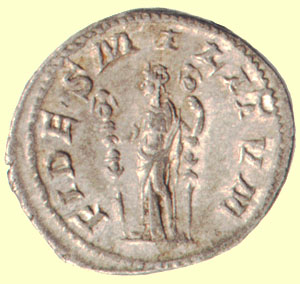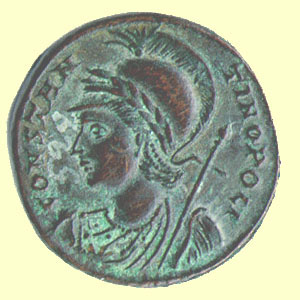 Contents -
Previous Article -
Next Article
Contents -
Previous Article -
Next Article
In a World Without Newspapers, Coins Delivered the Emperor’s Message to the People
One of the things that makes collecting Roman coins so interesting and fun is trying to read and decipher the message on the reverse. Often, the emperor used the reverses of coins to draw attention to his accomplishments. Some emperors commemorated their victories in war while others boasted about the construction of buildings, temples, and public works. Constantine and his sons issued coins from A. D. 330 to 346 commemorating his founding of an entirely new city which was to become greater than any other in Europe for the next thousand years. Surprisingly, these CONSTANTINOPOLIS types are inexpensive and easy to obtain. Denarii commemorating Hadrian's visits to every province of the empire during which he inspected the state of public buildings are also popular amongst collectors, although they are fairly expensive.
 Here was a small button of metal, touched by people in every station in life, and turned out by the millions in one of history's first mass manufacturing operations. The techniques of working copper, silver, and gold were well-known by the Third Century B. C., when the first pieces that could be recognized as Roman coins made their first appearance. Rulers and governments had already discovered the principle that coins were an ideal way to distribute propaganda and political messages because they were so easy to mass produce and distribute. The "books" of that day were rolled papyrus scrolls which were fragile, expensive, bulky, easily damaged by fire or water, and required that the user be able to read. Coins, on the other hand, were small and compact. The image and lettering struck on them lasted over twenty years in average circulation during which they passed through the hands of soldiers, rich merchants, government officials, and ordinary citizens. On the obverse or "heads" side was the portrait of the current ruler or a member of his family. On the reverse, the emperor might proclaim to the world how he protected the citizens of Rome by winning a great battle against her enemies, or announce that he had ensured an abundant supply of grain through his wise economic policy, or that he was just, kind, upright, wise, or generous. The portraits they bore of rulers and the messages portrayed on their reverses are clear to us even after 1500 to 2000 years.
Here was a small button of metal, touched by people in every station in life, and turned out by the millions in one of history's first mass manufacturing operations. The techniques of working copper, silver, and gold were well-known by the Third Century B. C., when the first pieces that could be recognized as Roman coins made their first appearance. Rulers and governments had already discovered the principle that coins were an ideal way to distribute propaganda and political messages because they were so easy to mass produce and distribute. The "books" of that day were rolled papyrus scrolls which were fragile, expensive, bulky, easily damaged by fire or water, and required that the user be able to read. Coins, on the other hand, were small and compact. The image and lettering struck on them lasted over twenty years in average circulation during which they passed through the hands of soldiers, rich merchants, government officials, and ordinary citizens. On the obverse or "heads" side was the portrait of the current ruler or a member of his family. On the reverse, the emperor might proclaim to the world how he protected the citizens of Rome by winning a great battle against her enemies, or announce that he had ensured an abundant supply of grain through his wise economic policy, or that he was just, kind, upright, wise, or generous. The portraits they bore of rulers and the messages portrayed on their reverses are clear to us even after 1500 to 2000 years.
Go to next article: Many Languages and Cultures Within One Great Empire
Go back to previous article: The Author's First Mailorder Ancient Coin Purchase
Return to Roman Coins Table of Contents
 Here was a small button of metal, touched by people in every station in life, and turned out by the millions in one of history's first mass manufacturing operations. The techniques of working copper, silver, and gold were well-known by the Third Century B. C., when the first pieces that could be recognized as Roman coins made their first appearance. Rulers and governments had already discovered the principle that coins were an ideal way to distribute propaganda and political messages because they were so easy to mass produce and distribute. The "books" of that day were rolled papyrus scrolls which were fragile, expensive, bulky, easily damaged by fire or water, and required that the user be able to read. Coins, on the other hand, were small and compact. The image and lettering struck on them lasted over twenty years in average circulation during which they passed through the hands of soldiers, rich merchants, government officials, and ordinary citizens. On the obverse or "heads" side was the portrait of the current ruler or a member of his family. On the reverse, the emperor might proclaim to the world how he protected the citizens of Rome by winning a great battle against her enemies, or announce that he had ensured an abundant supply of grain through his wise economic policy, or that he was just, kind, upright, wise, or generous. The portraits they bore of rulers and the messages portrayed on their reverses are clear to us even after 1500 to 2000 years.
Here was a small button of metal, touched by people in every station in life, and turned out by the millions in one of history's first mass manufacturing operations. The techniques of working copper, silver, and gold were well-known by the Third Century B. C., when the first pieces that could be recognized as Roman coins made their first appearance. Rulers and governments had already discovered the principle that coins were an ideal way to distribute propaganda and political messages because they were so easy to mass produce and distribute. The "books" of that day were rolled papyrus scrolls which were fragile, expensive, bulky, easily damaged by fire or water, and required that the user be able to read. Coins, on the other hand, were small and compact. The image and lettering struck on them lasted over twenty years in average circulation during which they passed through the hands of soldiers, rich merchants, government officials, and ordinary citizens. On the obverse or "heads" side was the portrait of the current ruler or a member of his family. On the reverse, the emperor might proclaim to the world how he protected the citizens of Rome by winning a great battle against her enemies, or announce that he had ensured an abundant supply of grain through his wise economic policy, or that he was just, kind, upright, wise, or generous. The portraits they bore of rulers and the messages portrayed on their reverses are clear to us even after 1500 to 2000 years.
 Contents -
Previous Article -
Next Article
Contents -
Previous Article -
Next Article